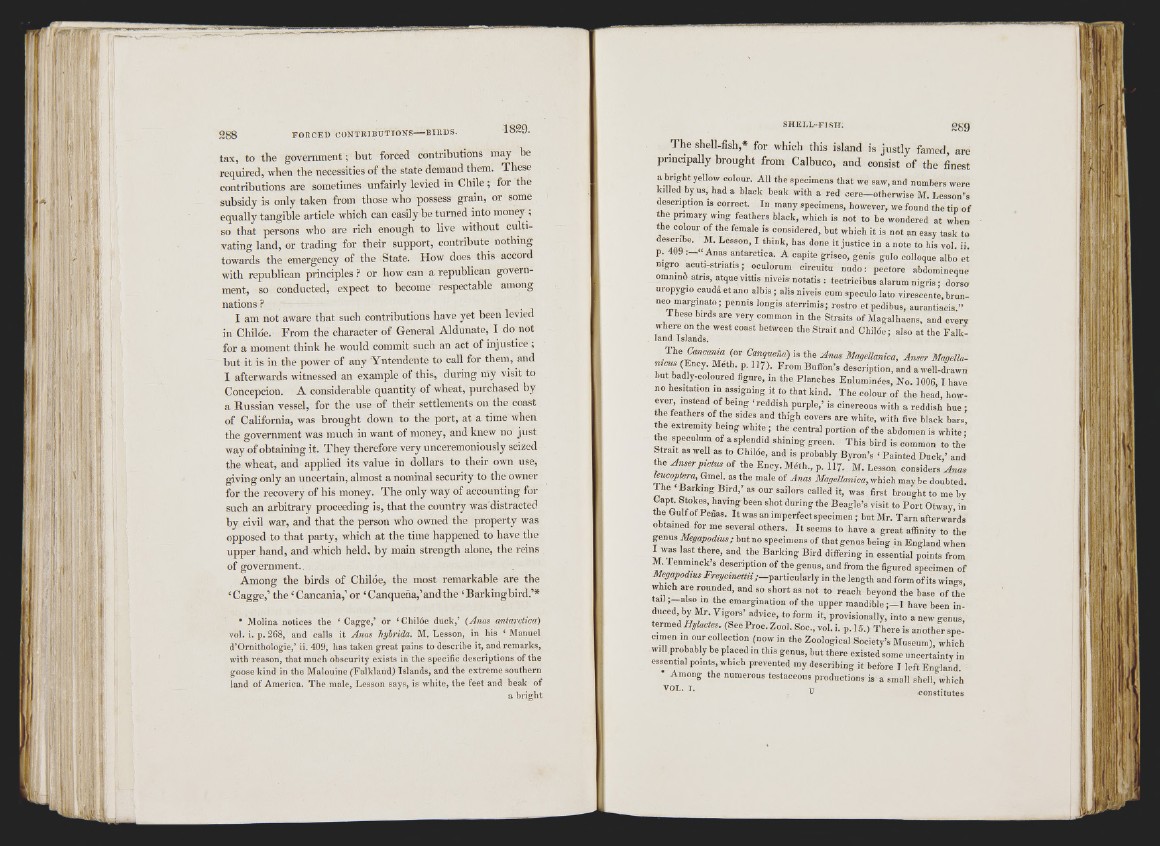
I h i'
FORCED CONTRIBUTIONS BIRDS.
tax, to the government; but forced contributions may be
required, when the necessities of the state demand them. These
contributions are sometimes unfairly levied in Chile; for the
subsidy is only taken from those who possess grain, or some
equally tangible article which can easily be turned into money ;
so that persons who are rich enough to live without cultivating
land, or trading for their support, contribute nothing
towards the emergency of the State. How does this accord
with republican principles ? or how can a republican government,
so conducted, expect to become respectable among
nations ?
I am not aware that such contributions have yet been levied
in Childe. From the character of General Aldunate, I do not
for a moment think he would commit such an act of injustice ;
hut it is in the power of any Yntendente to call for them, and
I afterwards witnessed an example of this, during my visit to
Concepcion. A considerable quantity of wheat, purchased by
a Russian vessel, for the use of their settlements on the coast
of California, was brought down to the port, at a time when
the government was much in want of money, and knew no just
way of obtaining it. They therefore very unceremoniously seized
the wheat, and applied its value in dollars to their own use,
giving only an uncertain, almost a nominal security to the owner
for the recovery of his money. The only way of accounting for
such an arbitrary proceeding is, that the country was distracted
by civil war, and that the person who owned the property was
opposed to that party, which at the time happened to have the
upper hand, and which held, by main strength alone, the reins
of government.
Among the birds of Chiloe, the most remarkable are the
‘Cagge,’ the ‘Cancania,’ or ‘Canqueña,’andthe ‘Barkingbird.’*
* Molina notices the ‘ Capjge,’ or ‘ Chilóe duck,’ {Anas antárctica)
vol. i. p. 268, and calls it Anas hybrida. M. Lesson, in his ‘ Manuel
d’Ornithologie,’ ii. 409, has taken great pains to describe it, and remarks,
with reason, that much obscurity exists in the specific descriptions of the
goose kind in the Malouine (Falkland) Islands, and the extreme southern
land of America. The male. Lesson says, is white, the feet and beak of
a bright
The shell-fish,* for which this island is justly famed, are
principally brought from Calbuco, and consist of the finest
a bright yellow colour. All the specimens th a t we saw, and numbers were
killed by us, had a black beak with a red cere—otherwise M. Lesson’s
description is correct. In many specimens, however, we found the tip o f
the primary wing feathers black, which is not to be wondered at when
the colour of the female is considered, hut which it is not an easy task to
describe. M. Lesson, I think, has done it justice in a note to his vol. ii
p. 409 Anas antárctica. A capite gríseo, genis guio colloque albo et
nigro acuti-striatis ; oculorum circuitu nudo ; pectore abdomineque
omninô atris, atque vittis niveis notatis : tectricibus alarum nigris ; dorso
uropygio caudâ et ano albis ; alls niveis cum speculo lato virescente. brun-
neo marginato; pennis longis aterrimis; rostro et pedibus, aurantiacis.”
i hese birds are very common in the Straits of M agalhaens, and every
where on the west coast between the Strait and Chilóe; also at the F a lk -
Jancl Islands.
T h e Cancania (or Canqucua) is the A n a s Magellanica, Anser Magella-
mcus (Ency Meth. p. I I 7 ). From Buffon’s description, and a well-drawn
but badly-coloured figure, in the Planches Enluminées, No. 1006, 1 have
no hesitation in assigning it to that kind. T h e colour of the head, how-
ever instead of being ‘reddish purple,’ is cinereous with a reddish hue ;
he feathers of the sides and thigh covers are white, with five black bars,
the extreinity being white ; the central portion o f the abdomen is white ;
the speculum of a splendid shining green. This bird is common to the
Strait as well as to Chilóe, and is probably Byron’s ‘ Painted Duck,’ and
the AnserPbcius of the Ency. Méth., p. I I 7 . M. Lesson considers A n a s
Imeopt^a, Gmel. as the male of Anas Magellanica, which may be doubted.
Th e ‘ B arking B ird,’ as our sailors called it, was first brought to me bv
C a p t Stokes, having been shot during the Beagle’s visit to P o r t Otway, in
the Gulf of Peñas. I t was an imperfect specimen ; but M r. T a rn afterwards
obtaine^d for me several others. I t seems to have a great affinity to the
genus Megapodms; b u tn o specimens of thatgenus being in England when
I was last there, and the Barking Bird differing in essential points from
M Tenmmck s description of the genus, and from the figured specimen of
Megapodms /-p a r t ic u la r ly in the length and form of its wings,
which are rounded, and so short as not to reach beyond the base of the
ta i I ; - a l s o m the emargination of the upper m a n d ib le ;- ! have been in duced
by Mr. Vigors’ advice, to form it, provisionally, into a new genus,
termed (hee P roc. Zool. Soc., yol. i. p. ] 5.) TTiere is another spe-
" '• 7 " ’u Zoological Society’s Museum), which
will probably be placed in this genus, but there existed some uncertainty in
essential points, which preyented my describing it before I left England
• Among the numerous testaceous productions is a small shell, which
F constitutes
iii::
J